
Trump’s first 100 days show him dictating the terms of press coverage − following Hungarian strongman Viktor Orbán’s playbook for media control
President Donald Trump shakes hands with Hungarian Prime Minister Viktor Orbán during a meeting in the Oval Office on May Läs mer…





